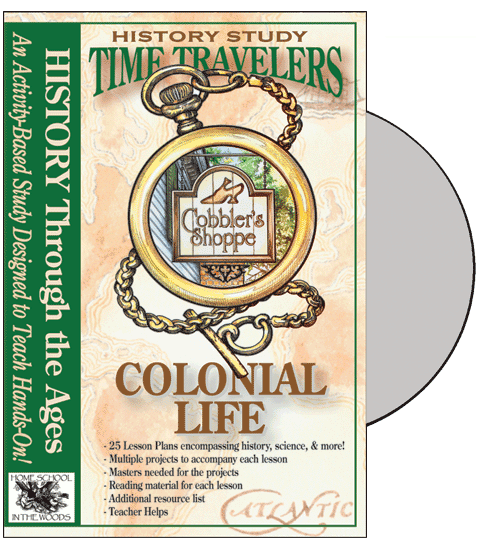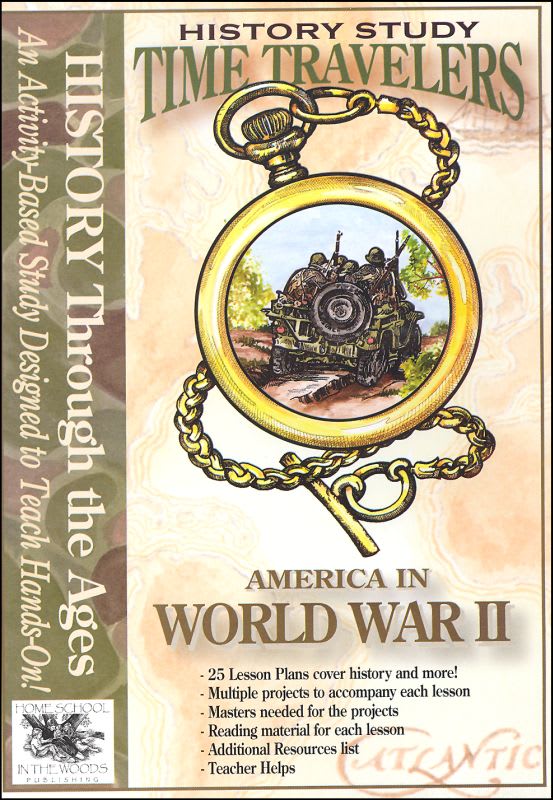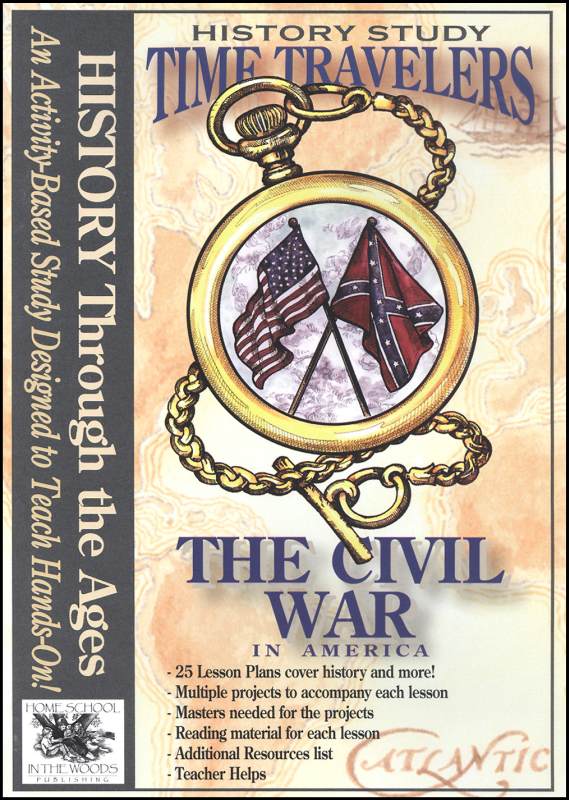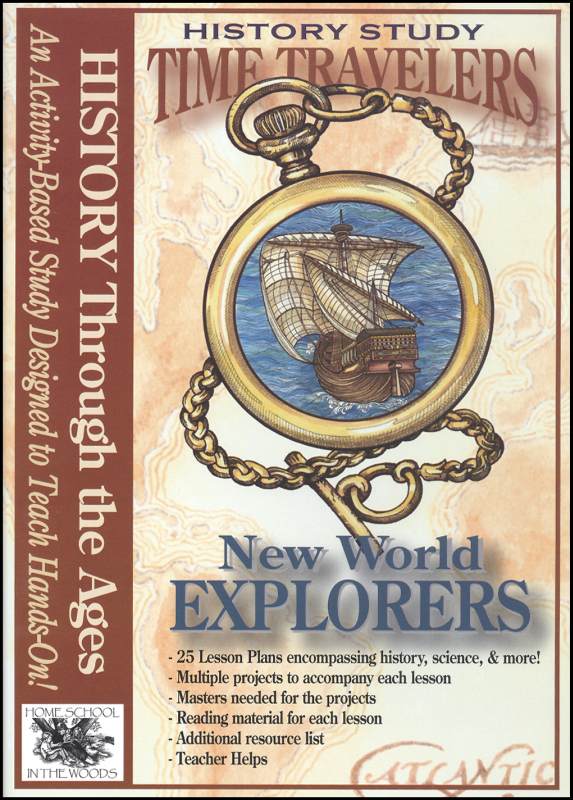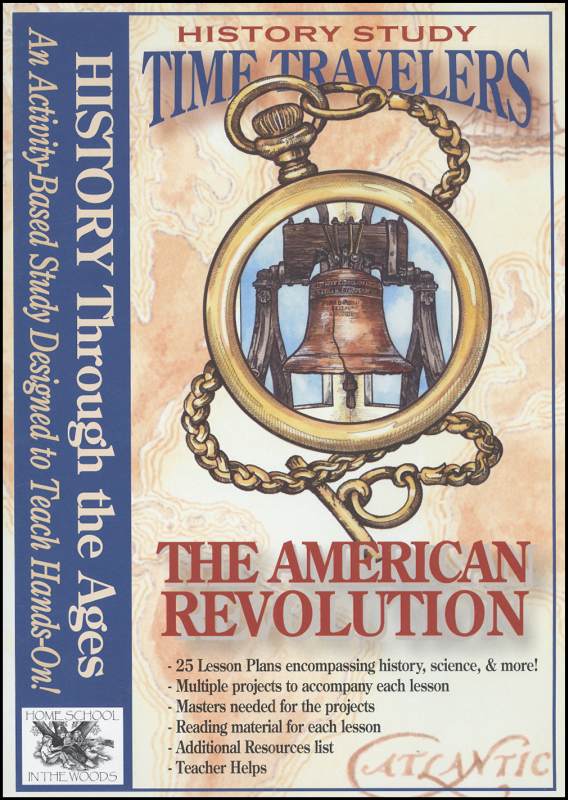History Study Time Travelers is a hands-on approach for learning history (U.S. history only at this time) for students in approximately grades 3 through 8. While the material is more than sufficient for history study for children in third and fourth grades (some even over their heads), you should use a more comprehensive text or "spine" book or assortment of real books to ensure adequate coverage of information for a complete course. A list of "Additional Resources" on the CD can help you identify some you might use.
There are seven CD-ROMs in the series thus far:
The New World Explorers
Colonial Life
The American Revolution
The Early 19th Century
The Civil War
The Industrial Revolution through the Great Depression
World War II
A single CD-ROM for each study presents information in PDF format and will run on either Windows or Mac systems. You will likely print out most of the pages on each CD. There is an amazing amount of material in each lesson, and lessons are presented in thorough detail with gorgeous artwork throughout. Four out of every five lessons begin with a brief two or three pages of "text" which serves as your source material as would a textbook. (The fifth lesson is a catch-up-on-projects day.) Then you choose from activities (from 35-50 activities per study) such as creating a timeline with figures and pages provided, creating and assembling lapbook components, writing articles for The Daily Bugle newspaper, constructing a replica of Jamestown from printed pages provided, practicing penmanship with pertinent quotations, creating "Factfile" cards for studying/reviewing information, hand dipping candles, doing creative writing, presenting a "shadow play," completing mapwork, creating and playing board games, doing science experiments, and cooking. The author suggests wrapping up each study with a party where students share what they've learned with friends and relatives.
Each student will create his or her own notebook to contain their work and the teacher should have her own binder for her planning and lesson presentation.
There are 25 lessons per study, with a number of activities for each lesson. You might do some or all of the activities. If you choose to do all the activities AND work with another text or collection of books, a single study could take a full school year. But since students need to study history beyond that of the U.S., it's more likely that you would use at least 2 or 3 of these studies over the course of a school year. Note that the lapbook projects alone from one of these studies might be sufficient hands-on activity for some learners!
Amy Pak incorporates some of her timeline figures from History Through the Ages along with dated mounting pages (in a different format from that used in History Through the Ages) so that students can create timelines as they study people and events of each period. Teacher keys illustrate where to mount figures, and the mounting pages also have titles of figures typed in faintly to show where they go.
Timelines, figures, and all other pages on the CDs may be printed out for all children in your family. And no problem if a child messes up their timeline figures or the fence for their fort reconstruction and needs new pages. Just print whatever you need.
Since this is a hands-on approach, you will need resources for the projects and activities. Primary items needed are colored printer paper, white card stock, colored card stock, glue, transparency film, colored file folders, binders, and colored pencils. You can see these are really quite inexpensive resources for all the activities that you will be able to accomplish.
Preparation and presentation time are needed. Older students might well do much of the preparation of materials for projects, but parents will still need to determine which projects need to be done and make sure materials are on hand. Younger children will need lots of help and direction from start to finish, while older children will likely be able to work independently on many projects once they've been shown what to do.
As I was reviewing The American Revolution CD-ROM, I found myself getting lost in the myriad of files—there's so much here!. Then I realized that it is likely that because I am a "whole-to-parts" type learner—I like to get the big picture first then figure out the details—I was coming at this review from the wrong direction. Other "whole-to-parts" parents might want to begin by looking at the "Photos of Projects" section on the CD. It shows photos of lesson activities in order so that you get an overview of what's involved. Keep in mind that photos don't show everything done in the lessons, but they give you a good idea of what you will be doing.
Studies are definitely Christian; quotations are frequently in reference to faith issues as are a few of the activities.
I can envision families using these studies, adapting choices to suit each of their children. Perhaps they would use more hands-on activities with one or two children, while allowing their avid reader to spend more time "in the books." The flexibility and creativity of these studies make them an excellent resource for teaching history.
Note: Also see Project Passport by Amy Pak for coverage of World History.




